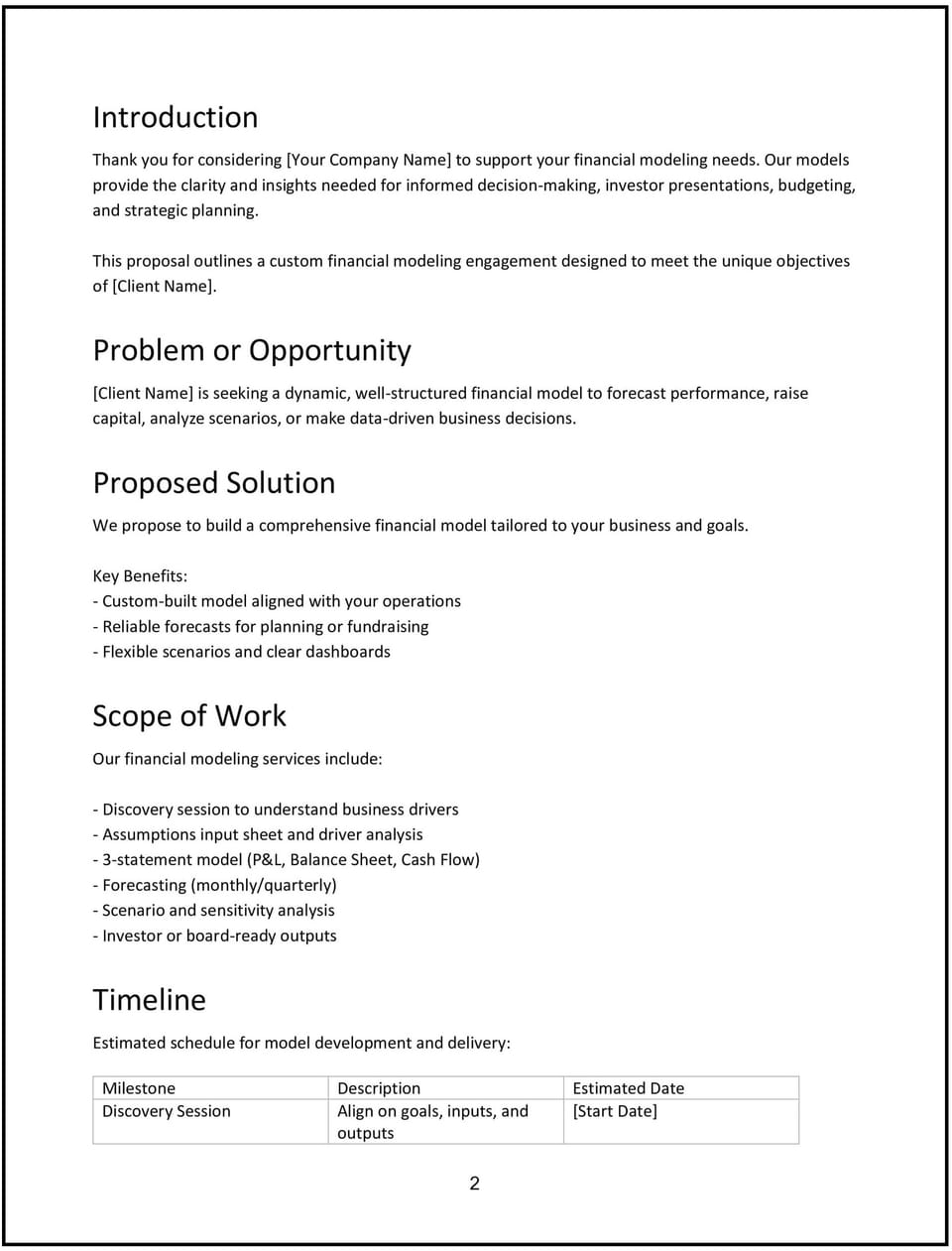Financial modeling proposal: Free template

Customize this free financial modeling proposal with Cobrief
Open this free financial modeling proposal in Cobrief and start editing it instantly using AI. You can adjust the tone, structure, and content based on your modeling approach, client goals, and business type. You can also use AI to review your draft — spot gaps, tighten language, and improve clarity before sending.
Once you're done, send, download, or save the proposal in one click — no formatting or setup required.
This template is fully customizable and built for real-world use — ideal for pitching forecasting models, fundraising prep, business planning, or financial scenario analysis. Whether you're a freelance finance consultant, CFO, or analyst, this version gives you a structured head start and removes the guesswork.
What is a financial modeling proposal?
A financial modeling proposal outlines how you’ll build, customize, or refine a financial model to help a client forecast outcomes, evaluate scenarios, or raise capital. It typically includes model scope, assumptions, deliverables, tools used, and pricing.
This type of proposal helps clients understand the purpose, structure, and value of a well-built model — and gives them clarity on timeline, collaboration, and outputs.
A strong financial modeling proposal helps you:
- Set expectations for structure, assumptions, and outputs.
- Clarify how your model supports decision-making or fundraising.
- Demonstrate your financial and strategic expertise.
- Align on scope, revisions, and delivery timeline.
Why use Cobrief to edit your proposal
Cobrief makes it easy to build, refine, and send polished proposals — with built-in AI to help you improve every section.
- Edit the proposal directly in your browser: No formatting delays or setup needed.
- Rewrite sections with AI: Clarify complex terms, simplify copy, or shift tone instantly.
- Run a one-click AI review: Spot vague areas and improve structure or flow.
- Apply AI suggestions instantly: Accept individual edits or apply all in one click.
- Share or export instantly: Send your proposal or download a clean PDF or DOCX file.
Write better proposals, faster — with zero formatting hassle.
When to use this proposal
Use this financial modeling proposal for:
- Building a new operating or financial forecast model.
- Supporting startup fundraising with investor-ready models.
- Creating scenario planning or sensitivity analysis tools.
- Updating or cleaning up an existing model.
- Responding to consulting RFPs that include modeling components.
It works for startups, SMBs, VCs, or corporate finance teams.
What to include in a financial modeling proposal
Each section helps the client understand your process, the value of the model, and what’s included:
- Executive summary: Outline the business objectives (e.g., fundraising, budgeting, strategic planning) and how your model will help clarify cash flow, runway, or ROI.
- Scope of work: Define the model's purpose — e.g., 3-statement model, SaaS operating model, DCF, investor-ready pitch model, cap table projections. List included tabs and logic.
- Inputs and assumptions: Explain how assumptions will be gathered (e.g., provided by client, based on benchmarks) and what types of inputs you’ll model.
- Deliverables: Detail what you’ll provide — e.g., Excel or Google Sheets model, visual summary dashboards, instructions, or video walkthroughs.
- Revisions: Clarify how many review rounds are included and what qualifies as a revision vs. a new request.
- Timeline: Set expectations for delivery (e.g., 7–10 days) and any interim milestones (e.g., draft review).
- Pricing: Present your fee — fixed, hourly, or phase-based. Include add-ons like ongoing updates or investor Q&A prep.
- Terms and conditions: Cover confidentiality, access to documents, ownership of the final model, and payment terms.
- Next steps: End with a clear CTA — like “Reply to confirm,” “Send your assumptions,” or “Schedule a kickoff call.”
How to write an effective financial modeling proposal
This proposal should feel analytical, confident, and collaborative:
- Show your understanding of the business: Tailor the scope to their goals — not just a generic model.
- Emphasize clarity and usability: Position your model as a decision-making tool, not just a spreadsheet.
- Define deliverables precisely: Clients want to know what’s included, editable, and investor-ready.
- Keep language professional but accessible: Avoid jargon unless your client is finance-savvy.
- Use clean formatting: Headings, bullets, and short paragraphs aid scannability.
- Include a clear action step: Help the client move forward easily.
Frequently asked questions (FAQs)
Can I reuse this proposal across industries?
Yes — just tailor the model type, metrics, and assumptions to the client’s sector.
Does this proposal work for both startups and mature businesses?
Absolutely. The format is flexible — update the scope to fit the business size and complexity.
Should I include a sample or past model?
Yes — sharing a redacted or example output can build trust and showcase your structure.
Is this proposal legally binding?
No — this is a proposal. Attach an engagement letter or agreement separately if needed.
Can I export this as a PDF or DOCX file?
Yes — after customizing, you can download it instantly in either format.
This article contains general legal information and does not contain legal advice. Cobrief is not a law firm or a substitute for an attorney or law firm. The law is complex and changes often. For legal advice, please ask a lawyer.